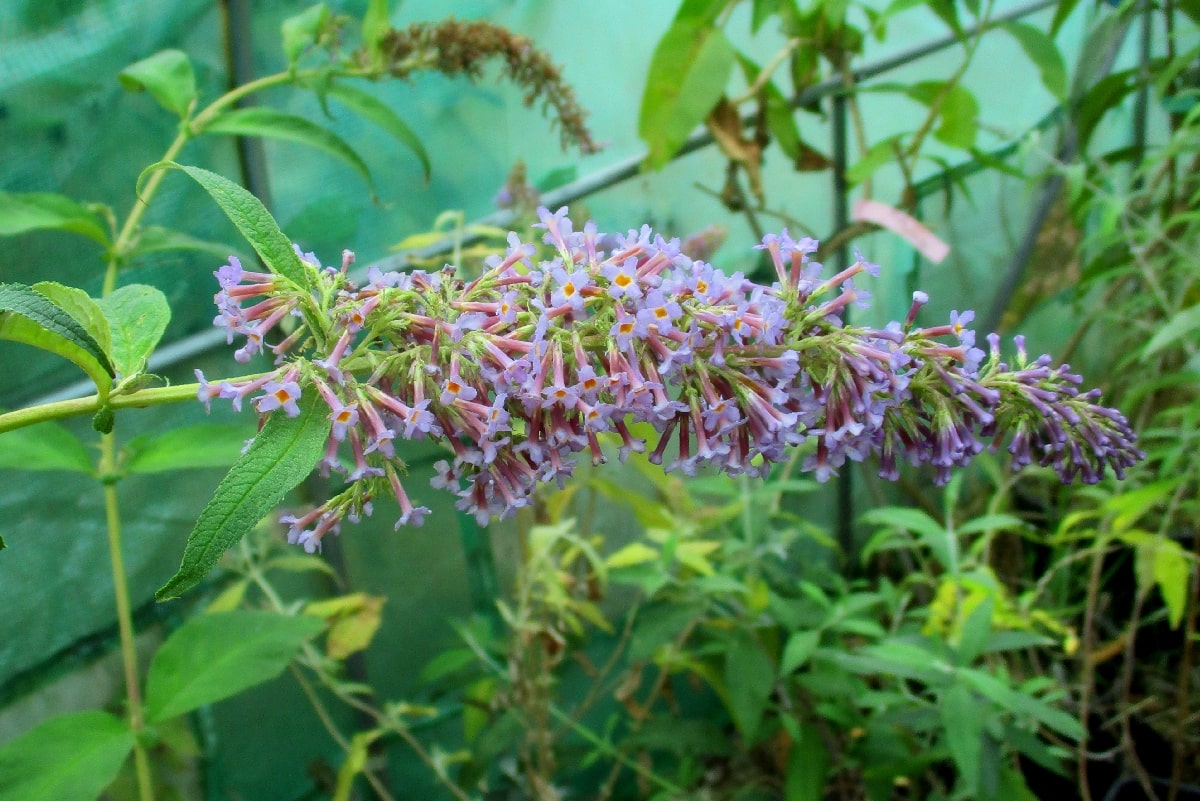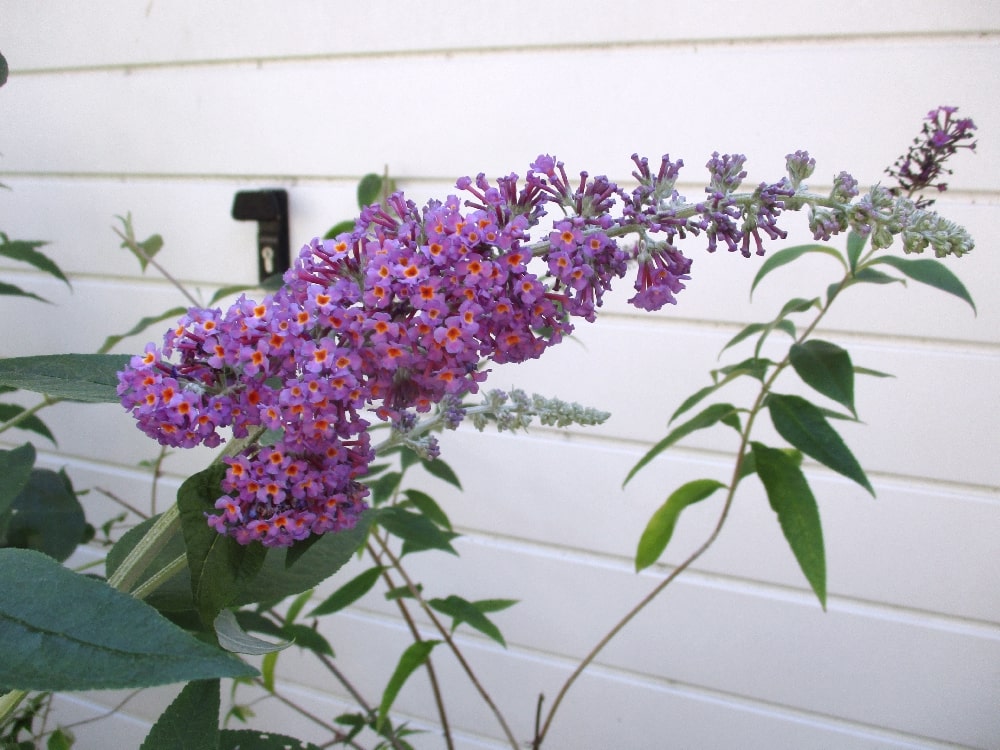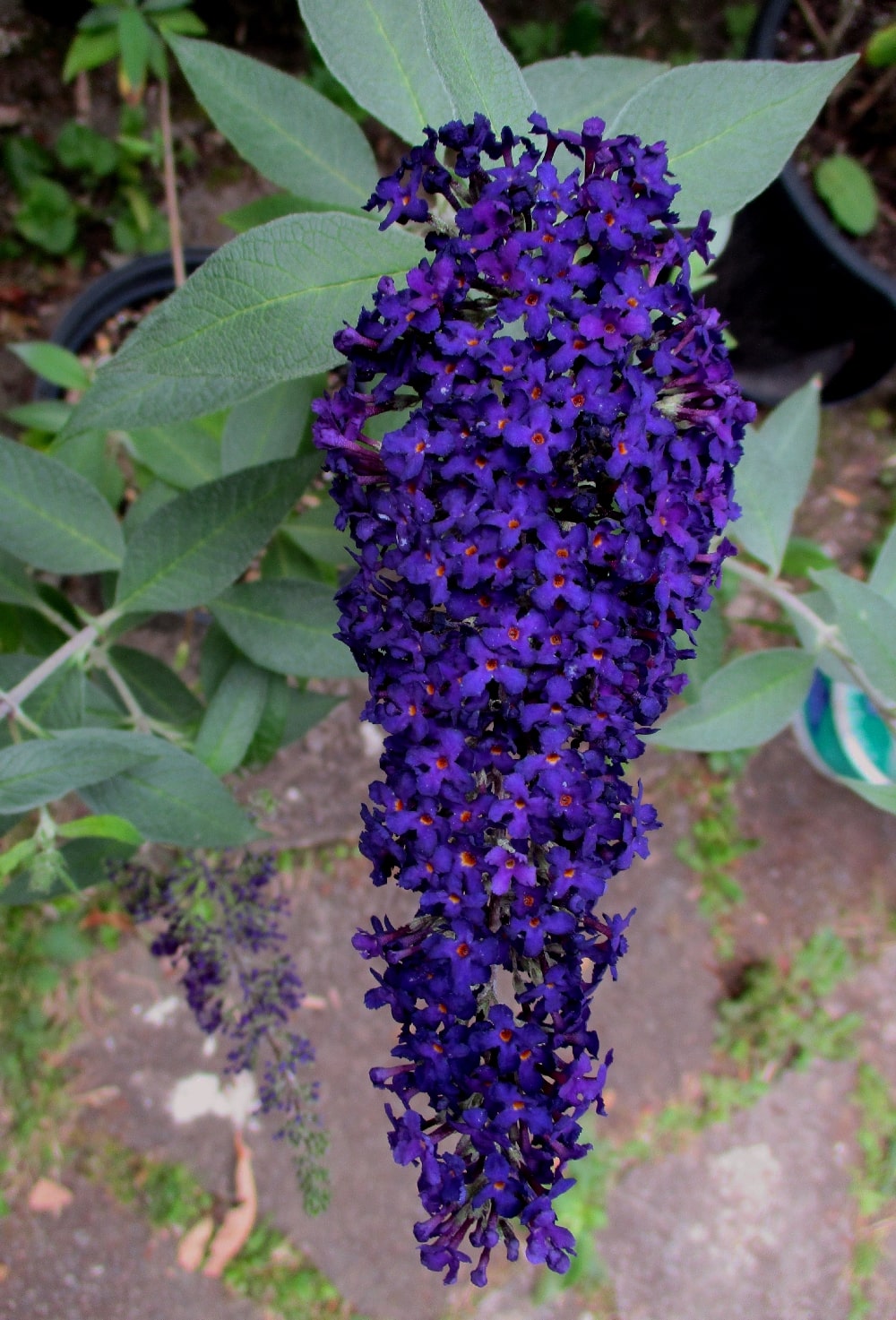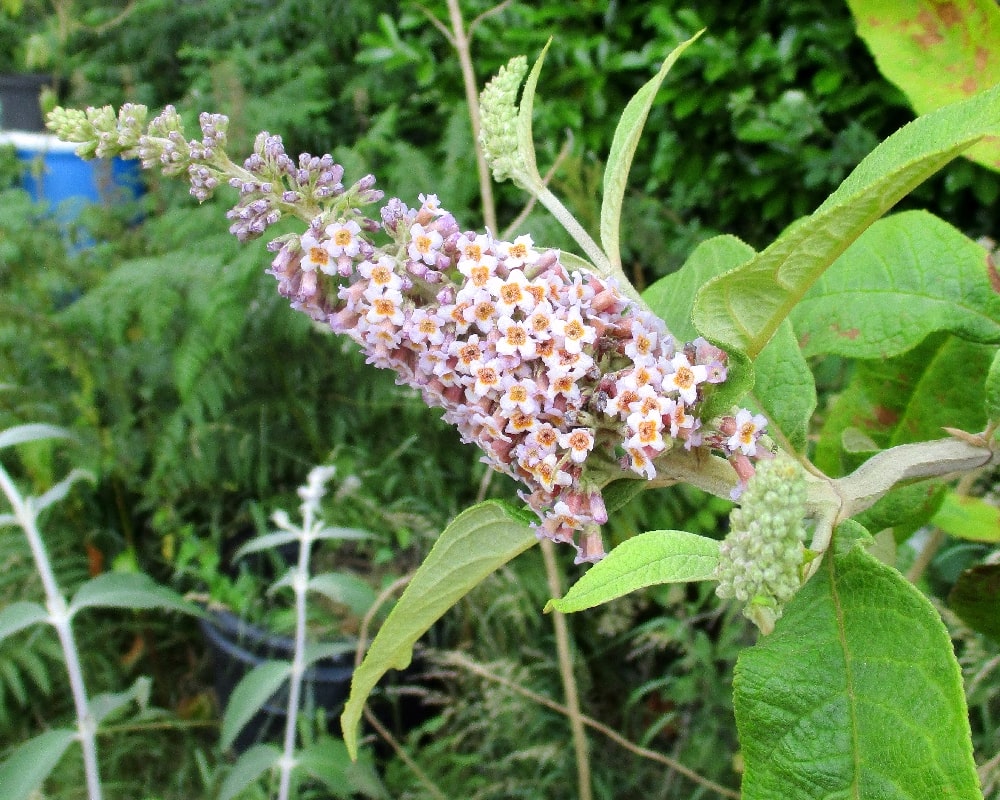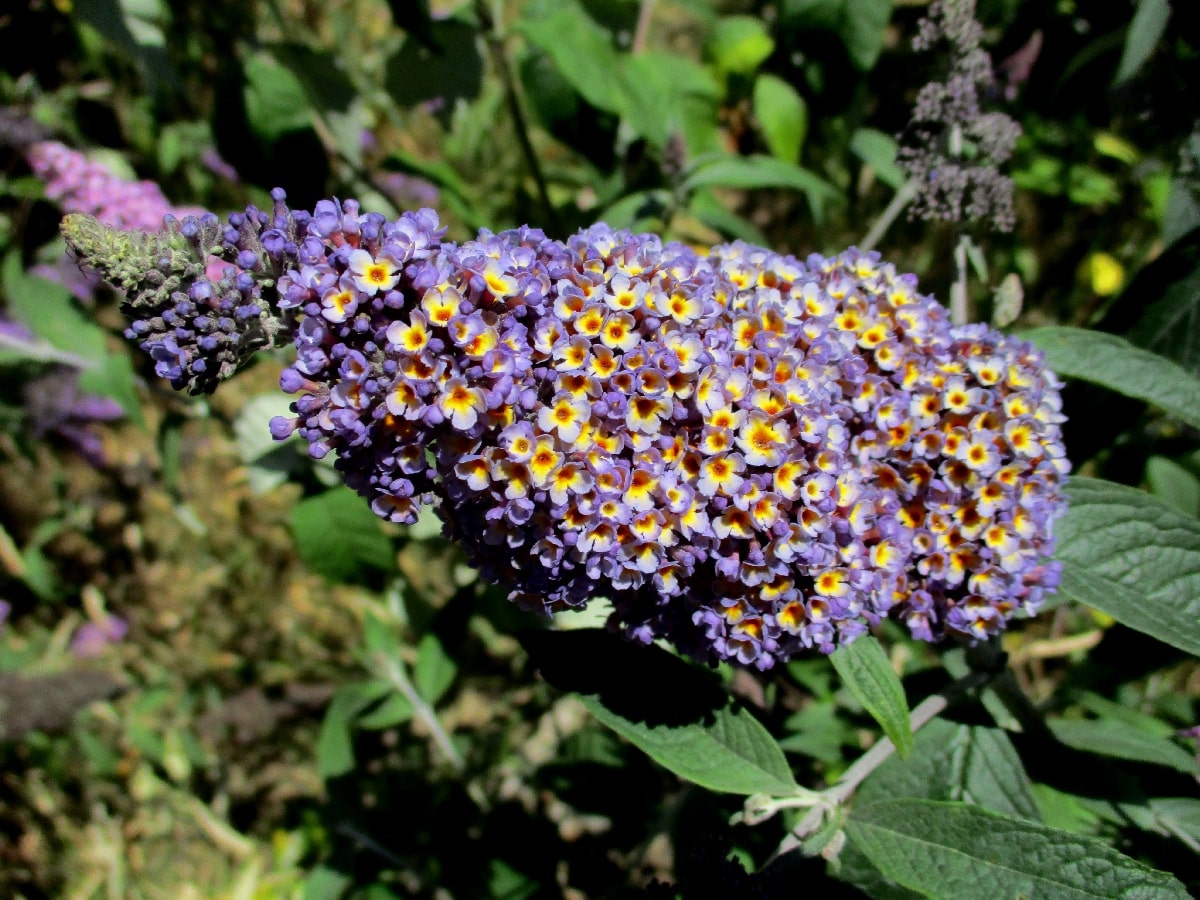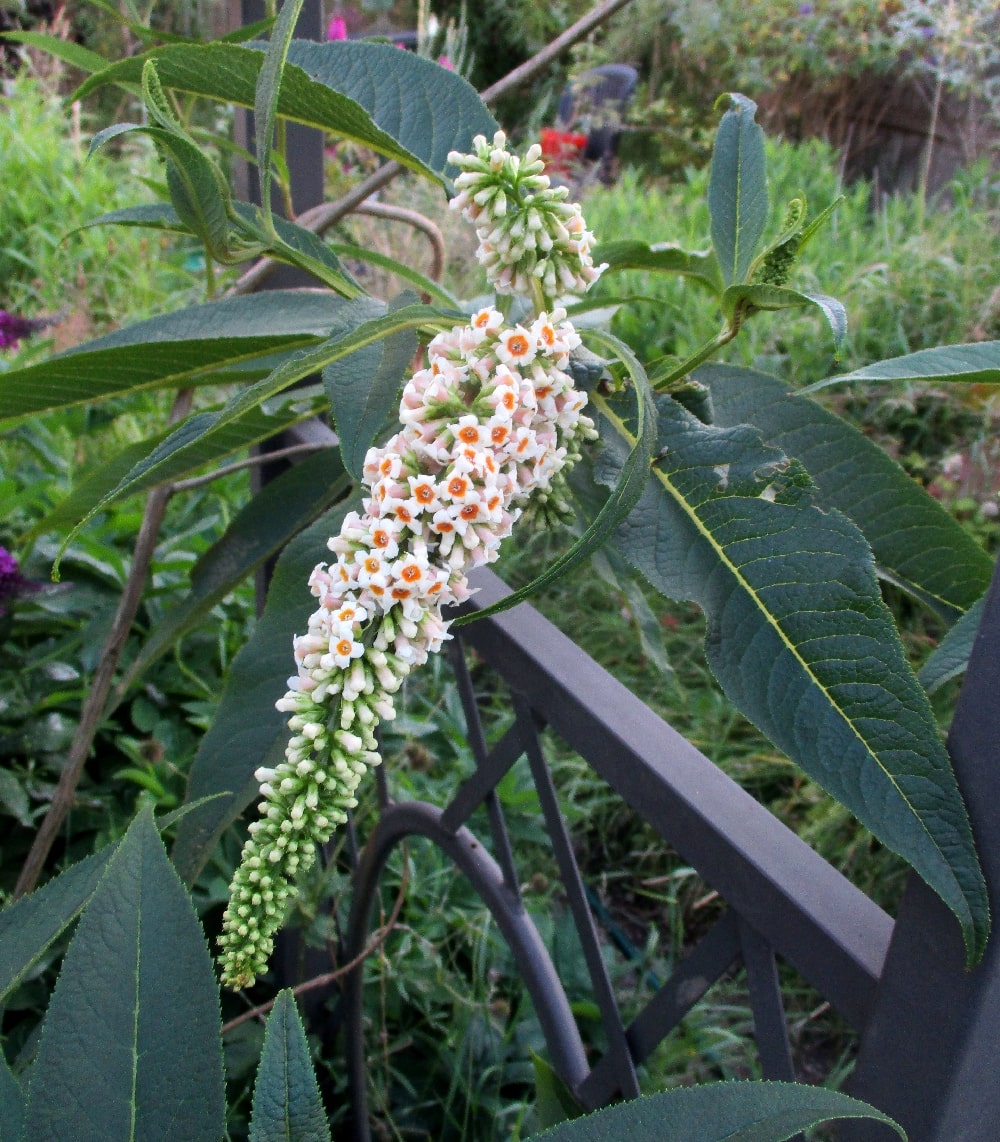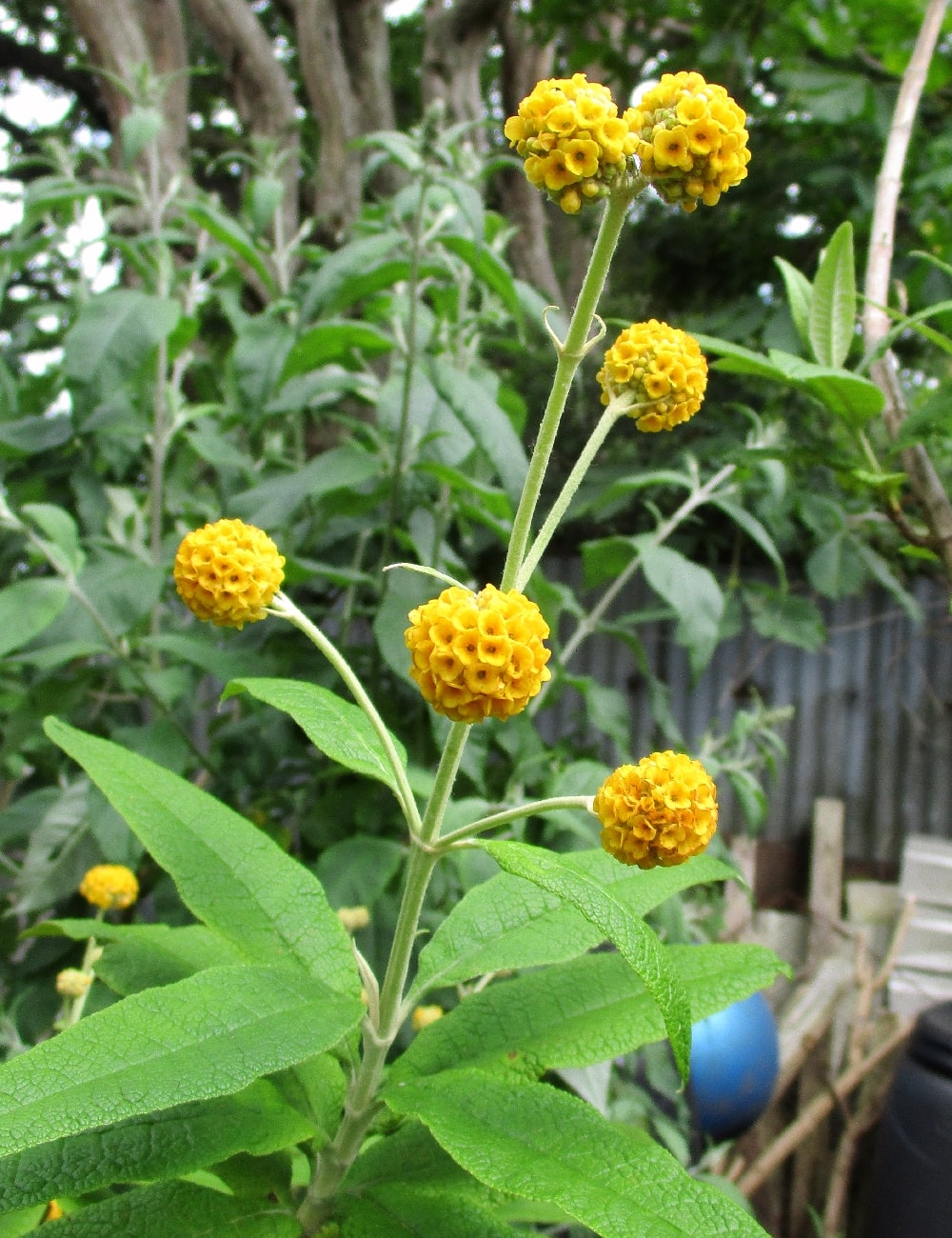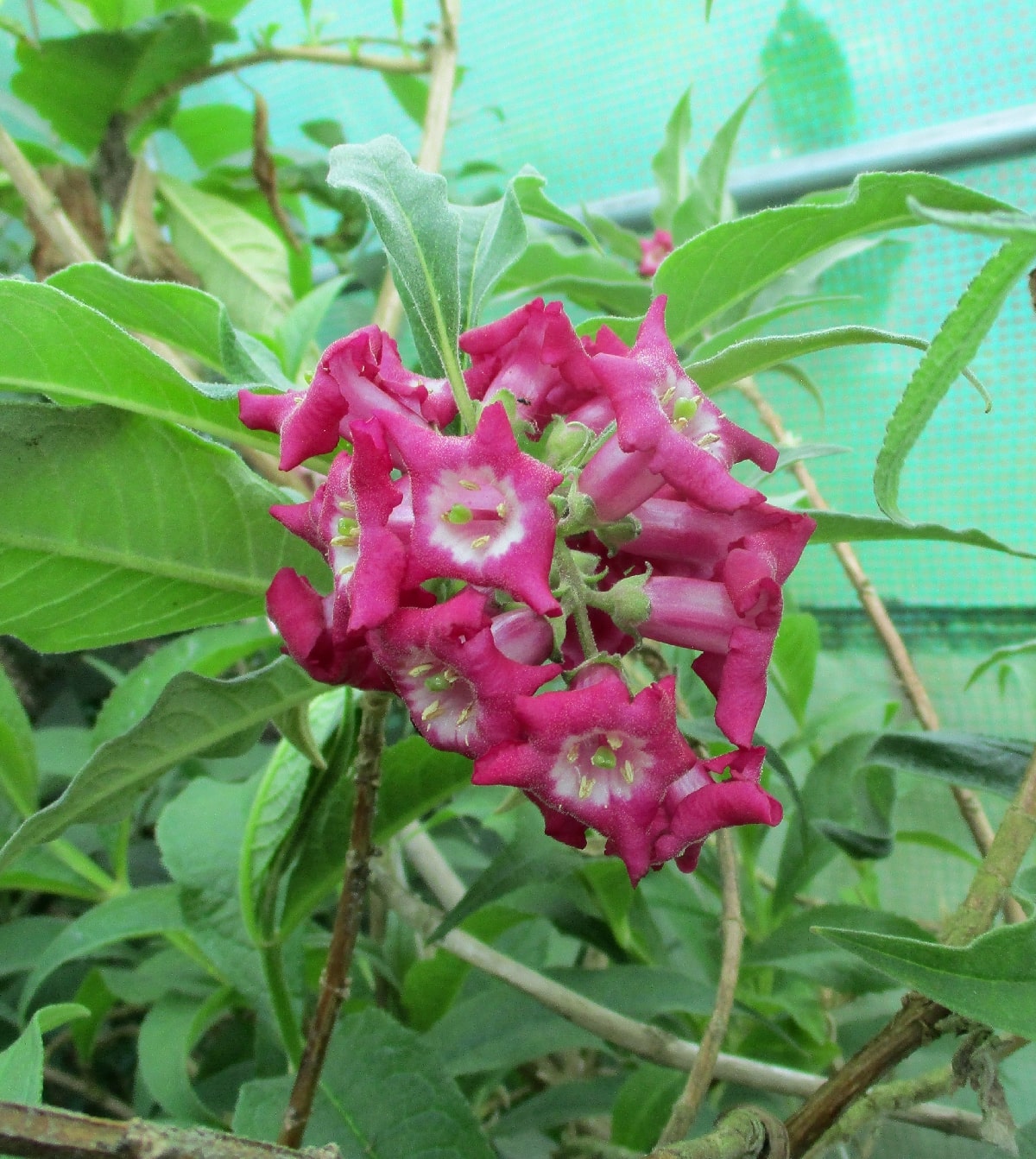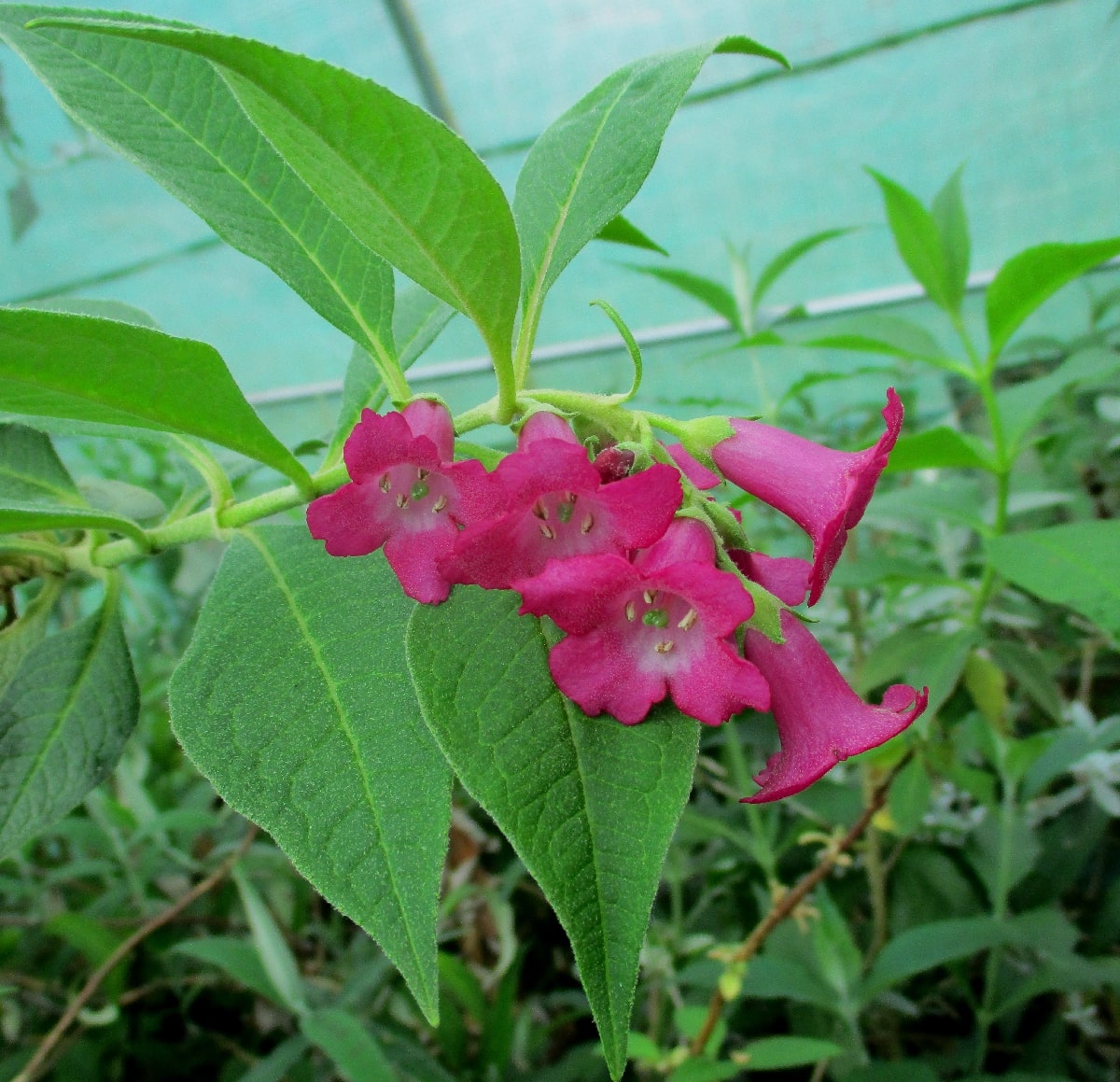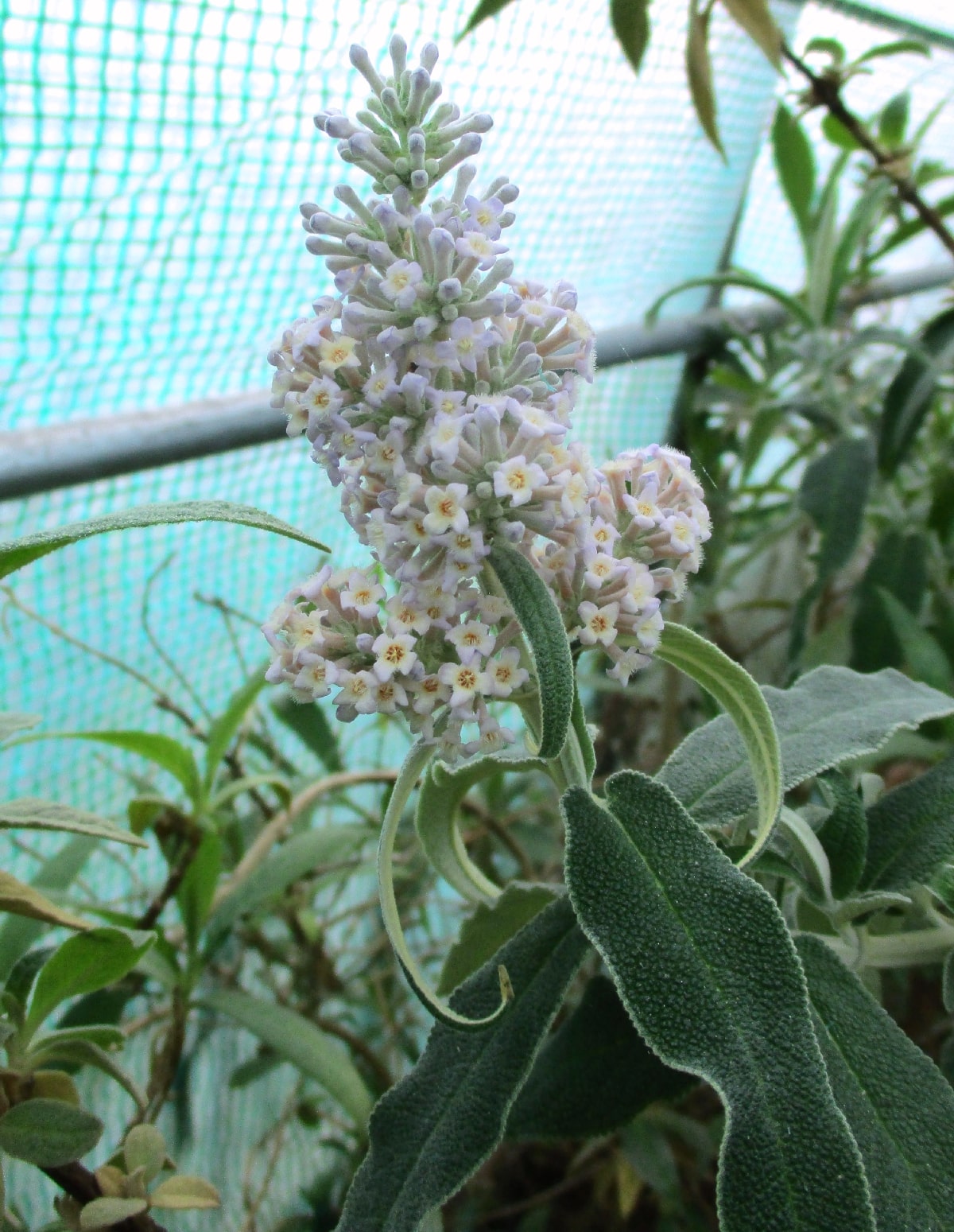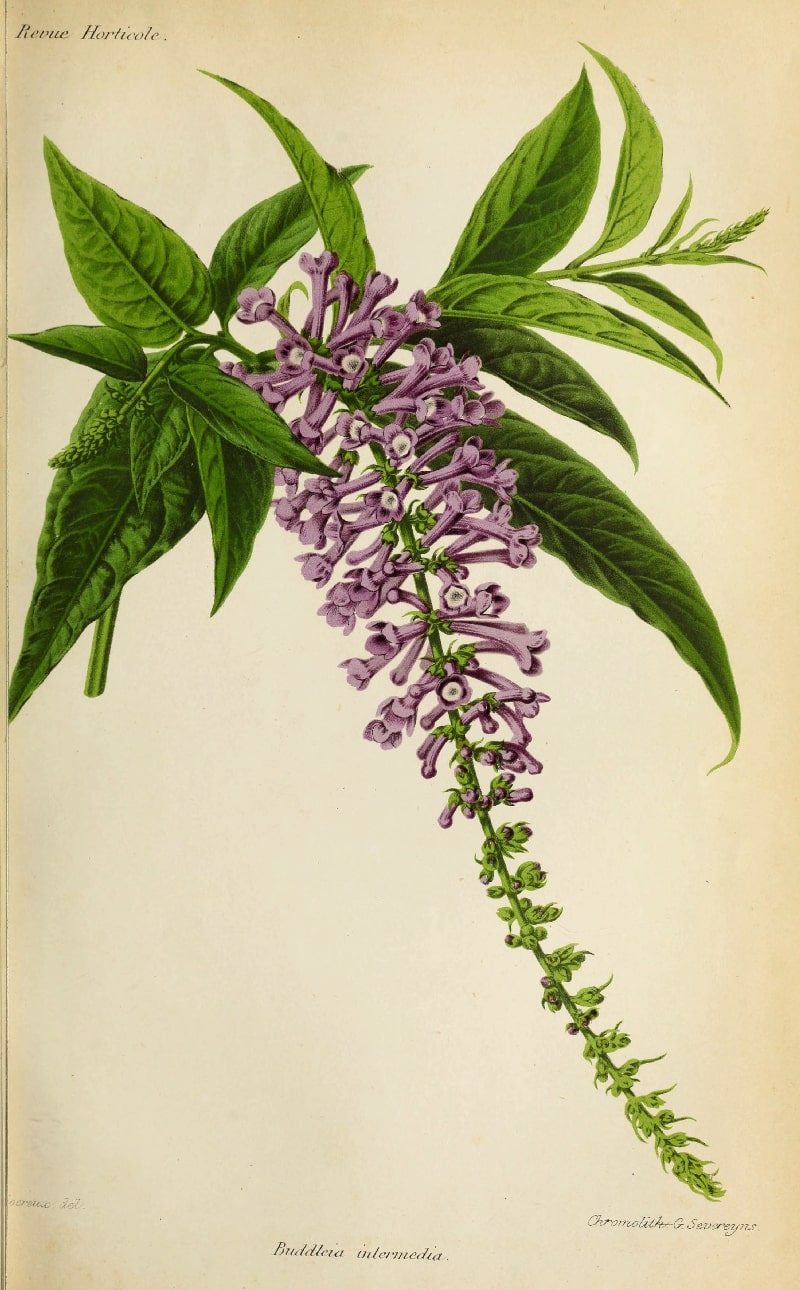
Buddleja asiatica
15th September 2022
Buddleja asiatica is a slightly tender species, usually grown as a greenhouse specimen. The one shown is collection W/O 9086, seed from Chengdu in Sichuan, China. This is right at the northern most end of the species range and the plant should be a little hardier than usual. I only brought it in for a few of the coldest nights last winter and it seems fine.
The inflorescence is a large spray of several panicles, with many really tiny white flowers, each only 3mm or so across. The close-up of the flowers shows they are pretty much the same as related species, just tiny. The species is reported to have a fine scent, but I've been unable to detect much perfume at all in this example.
The leaves are a paler green and very lightly covered in pale tan hairs, as are the stems. It should be everygreen provided there is enough protection from frosts. Normally, I would expect it to flower in the winter or early spring. However, it's flowering now. Why, I don't know - possibly the very hot summer or altered phenology due to its northern origins. Whether it will flower again in the spring or next autumn, or wait until spring 2024, remains to be seen.
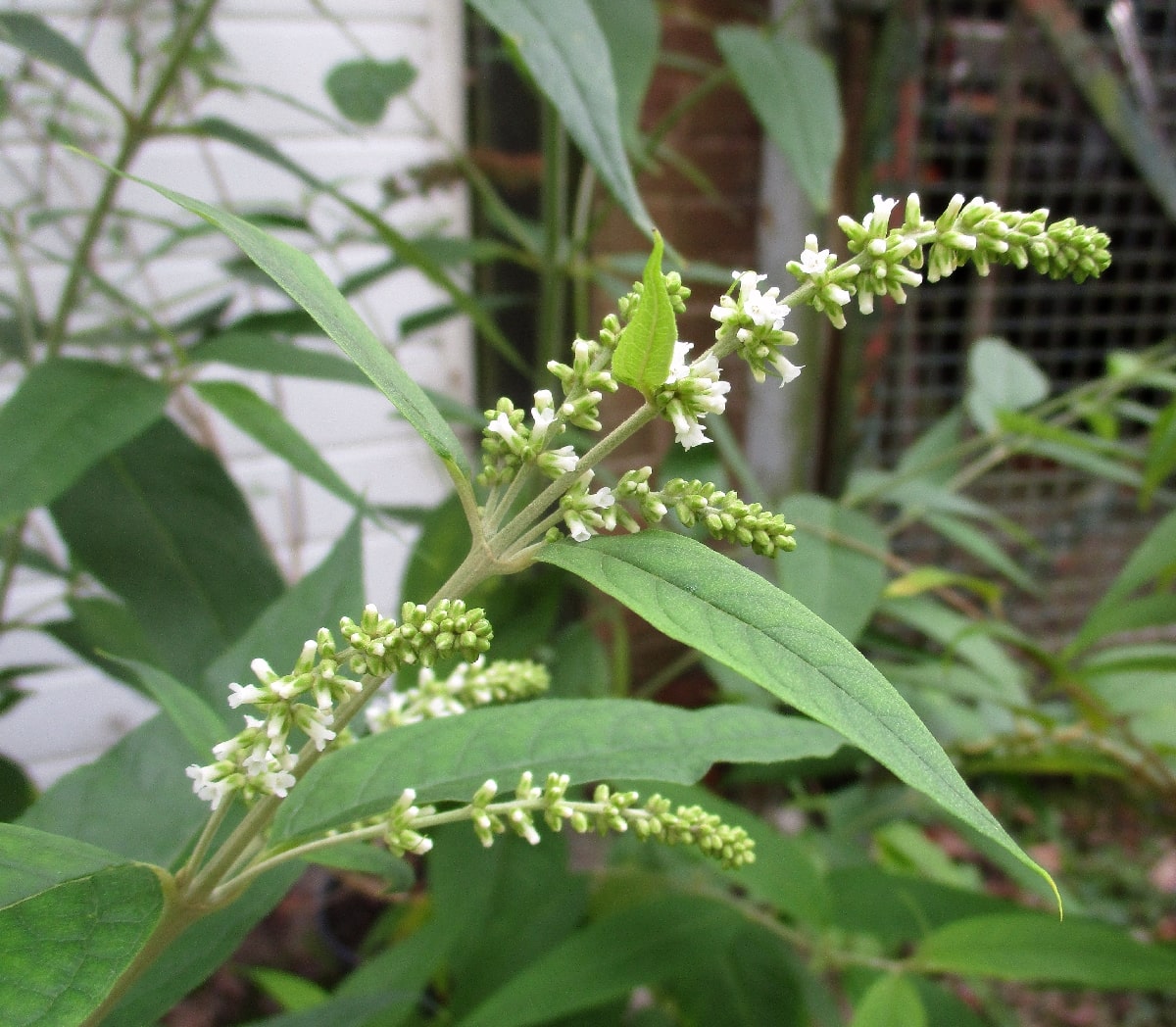
Buddleja asiatica has tiny flowers arranged in multiple panicles.
Open full size image in a new window
B. davidii x B. globosa F1 HYBRID
1st September 2022
The B. x weyeriana F2 hybrids were bred a century ago, and no one has since repeated the same hybridisation to my knowledge, the more recent 'Sungold' being a sport rather than a seedling. A few years ago, I was kindly given a few of cuttings of new F1 hybrids of B. davidii 'Nanho White' x B. globosa by Katrijn van Laere (ILVO, Belgium). These are distinct from the now lost F1 hybrids of Weyer: the parent plants are different and, unlike Weyer's F1 hybrids, the pollen parent is a tetraploid B. globosa.
Originally, the flowers of the one shown were yellow, but as the plants has matured they have tended to be flushed with a violet pigment, and only fade to yellow in warm conditions. The plant is a very slow grower, so it has taken a few years to show the true form. It is, however, seed fertile and I have open-pollinated seeds growing, but the progeny have yet to flower. The other F1 hybrid (see here) I have is white flowered, doesn't produce seed and I suspect it produces little or no pollen, so an F2 generation like Weyer's appears out of reach for now.
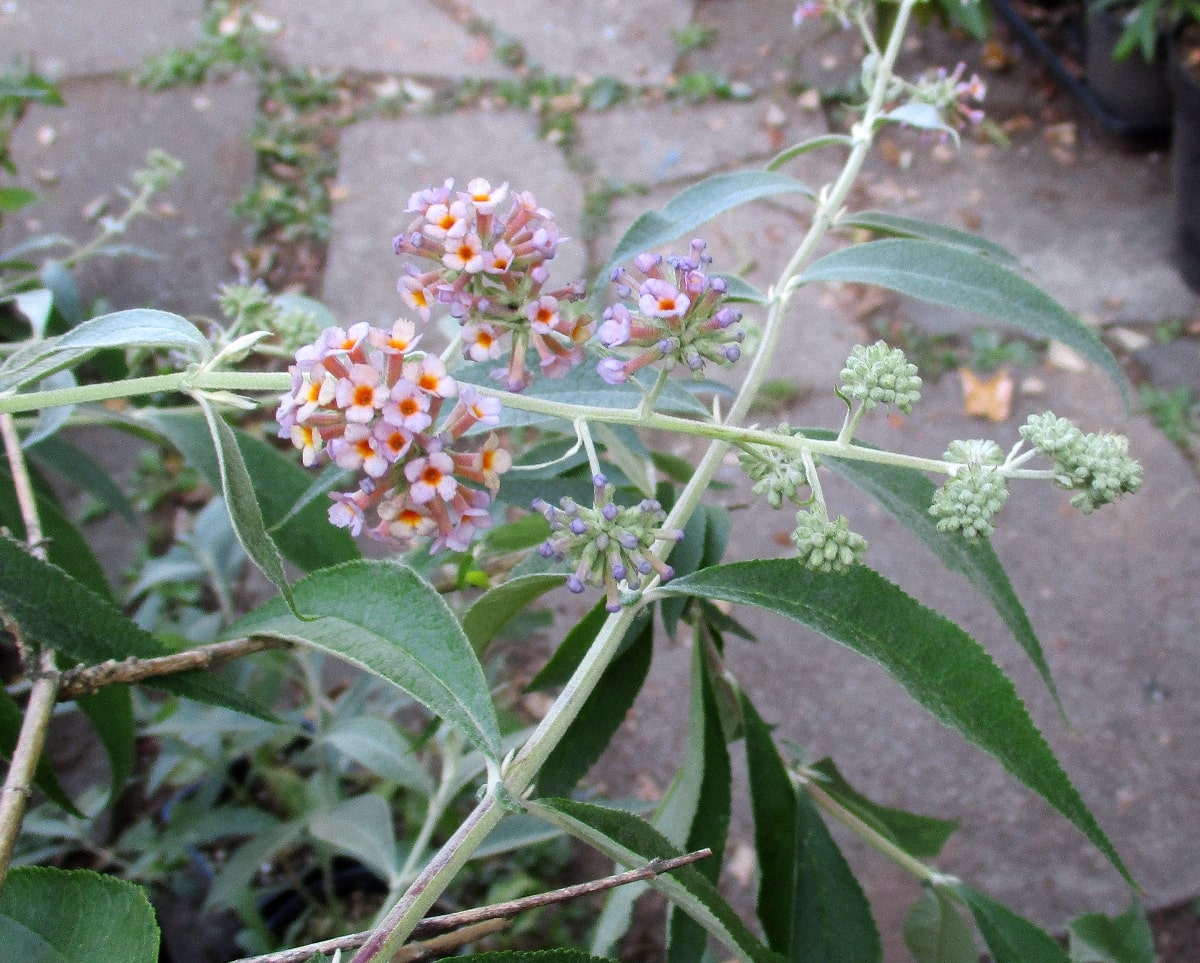
The B. davidii x B. globosa hybrid has flowers arranged in loose balls, but otherwise resembles B.davidii
Open full size image in a new window
Another Wild Thing
23rd August 2022
This is a plant of seed collection W/O 9010, from Sichuan (Chengdu, Xiling Xueshan, 1700m). Looking a little like some of the B. albiflora hybrids I've raised, dissection of a flowers confirms it's pure B. davidii. The stamens are in the lower half of the corolla tube, so it's not B. albiflora or B. myriantha (or a hybrid of these), both of which have their stamens in the throat.
Overall, a rather ugly and straggly example of the species, with somewhat loose panicles of insipid flowers. Nonetheless, it's an interesting plant. When compared to the other wild collections I grow, it demonstrates the wide variation in the native population of this species.
Contrasting Eyes
11th August 2022
Last time I pointed out how a bright eye can reduce the impact of a Buddleja flower and my attempts to reduce the yellow-orange eye in darker cultivars. I've also been increasing the eye, and the flower shown is a Buddleja fallowiana hybrid with a yellow centre more conspicuous than the average. Although the colour is an unremarkable mauve, the flower up close is quite striking, with the contrasting golden-yellow centre really showing up against the mauve.
Now, if only I could make the main colour darker…
Creating the Darkest Flowers
9th August 2022
There is still room for improvement with many of the established Buddleja cultivars. With so much concentration on breeding miniature Buddleja, most of which have proven utterly useless as garden plants, there has been little happening with the more traditional Buddleja davidii type.
One thing I've noticed is how the eye of the flower (technically the throat of the corolla tube), with its contrasting colour, affects the overall appearance. A bright golden or red eye adds to some shades, making them really striking, whereas with some darker colours the eye detracts from the intensity. I've been trying out crosses to both decrease and increase the eye.
'Black Knight' is a very old cultivar and deservedly remains popular as one of the darkest and richest shades of any Buddleja. However, the flower has a conspicuous golden eye and also the purple fades a towards the eye as the flower matures. I thought how striking the flowers would be if the colour were more uniform and the eye less prominent. BUZZ® INDIGO has a very dark flower, but also has one or two less appealing traits consequent of its dwarfing habit.
The flower shown is a work in progress, bred from a dark cultivar of my own. Although the new plant's flower is really dark and the eye much reduced, the colour is more blue than I would like; I'm really looking for the 'Black Knight' rich purple. On the plus side, it is perhaps one shade darker than the BUZZ® INDIGO, and with a good dense habit. I can't simply cross my plant with 'Black Knight', as I know from experience the yellow eye and centre-fading is passed on to some extent. It looks very much like I will have to breed a new solid purple Buddleja to achieve my aims, probably via 'Royal Red'.
B. forrestii x
B.macrostachya
23rd July 2022
I've grown a number of Buddleja macrostachya from seed, and so far have been unable to find a hybrid from amongst the seedlings. I've tried hand-pollinating with B. forrestii and B. nivea, species I hoped would be compatible, and got nothing. On the other hand, I've raised several hybrids of B. forrestii. Despite the obvious similarity between B. forrestii and B. macrostachya, they don't seem overly keen to cross with one another, although the literature suggests hybrids exist in the wild.
I have now raised this hybrid ex situ. The seed parent is the same white-flowered B. forrestii whose pollen was used to produce the hybrid shown below. The pollen parent is B. macrostachya RF 040, also with white flowers. Neither is ambiguous, yet both were carelessly mislabelled when I got them.
The hybrid is a perfect intermediate. The leaves have a smoother upper surface, like B. macrostachya RF 040, and brown fine hairs (tomentum) cover the new stems and some parts of the flower. However, the stems are square and winged like the B. forrestii parent. The flowers, although scented much like B. macrostachya, are also a good indicator of its hybrid status. From afar the inflorescences could be from either species. Things get more interesting when looking at the individual flowers. The corolla tube is cylindrical, narrow and intermediate in length between the species, and has the tomentose exterior typical of B. macrostachya, although perhaps a little less densely so than in the parent plant. Dissection of a flower shows the stamens are in the throat, typical for both species. However, the stigma is just below the level of the stamens. In B. macrostachya the stigma is typically much lower due to the long corolla tube, and in B. forrestii the stigma is practically level with the stamens because the tube is relatively short - so I would describe the hybrid as being neither one thing nor the other. The ovary is tomentose (hairy), and not glabrous (hairless) like those of B. forrestii.
There is much more about the two species on my dedicated B. forrestii and B. macrostachya page.
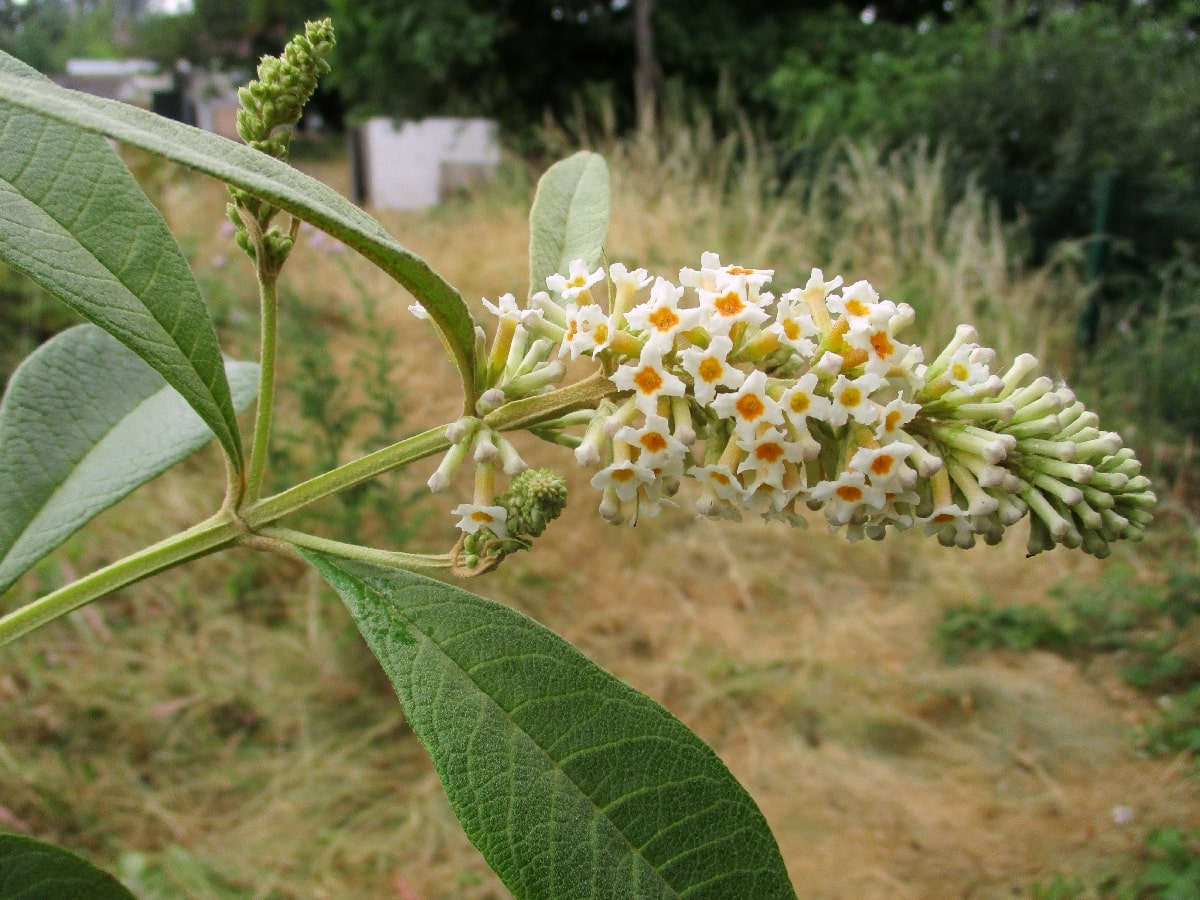
From a distance, the hybrid could be mistaken for B. forrestii or B. macrostachysa, having the general appearance of both.
Open full size image in a new window
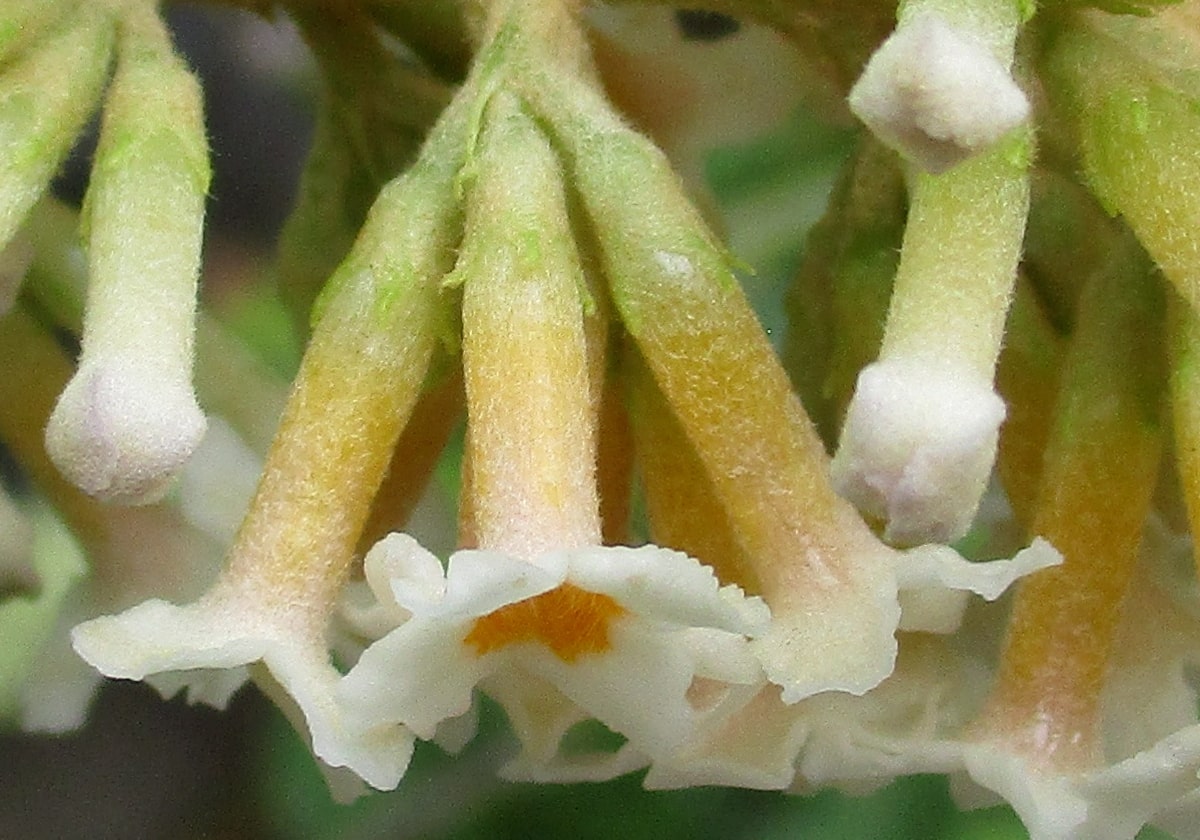
The corolla tubes are a little shorter compared to B. macrostachya, but they are cylindrical and the exterior tomentose.
Open full size image in a new window
B. nivea x B. forrestii
21st July 2022
I just cannot help keeping seeds from my species Buddlejas and growing the resulting hybrids. Many have to be discarded once they've flowered, and I only get to keep a few. This one is a hybrid of B. nivea (pink form), unusual because the floccose indumentum of that species has not been inherited. I've usually found the B. nivea features to be dominant over other species in its hybrids. The pollen parent was a white-flowered B. forrestii, and I'm really surprised how the B. forrestii genes seem to be dominant in this case. Hybrids of B. nivea and the limitanea type of B. forrestii are almost indistinguishable form B. nivea.
I'd put this plant to one side to discard. Having seen this year's flower, I've changed my mind and will try to keep it going. Should it prove fertile, I may even use it for future hybridisations.
Yellow Centred
Buddleja flower
19th July 2022
Occasionally you get a new type of flower when raising Buddleja davidii seedlings. A few years ago I grew a seedling which developed a yellow centre far more extensive than the usual yellow eye - I called it 'Rhubarb and Custard'. This was a happy accident, as I was actually trying to produce a white centre to the flower.
I grew some seedlings of a second generation to see whether this trait would pass on, with mixed results. I had a lot of plain pale blue flowers, and only a few interesting looking flowers where I'd used the 'Rhubarb and Custard' pollen to fertilise another plant. The one shown has the best form so far, a decent blue flower with a yellow centre. Sadly the recent intense heat and sun has bleached out the yellow, although I remain hopeful I can eventually breed the yellow to be completely stable and reliable.
Buddleja forrestii
W/O 7061 Part 2
11th July 2022
The collection W/O 7061 from south Sichuan (Liangshan at 2775 metres) has resulted in a group of quite varied plants. Their variation leads to me suspect the parent plant is not self-fertile, or else B. forrestii is in a sufficient density in this location to make out-crossing favoured.
I've planted one of these in my garden, in a less than ideal position. The need to get plants out of pots and into the ground meant I couldn't be choosy, so I can't be certain it will overwinter successfully.
The flower form of this one is distinct from the specimen shown below (6th July) - the flowers are pure white but for the orange eye and without an apparent purple flush in bud. Although the leaves are large and robust, the individual flowers are a little more delicate. A close look at the flowers confirms the species is B. forrestii, with short corolla tubes widening towards the throat.
To my eye, this second W/O 7061 is more decorative than the first, brighter flowers and darker foliage, and I will probably take a cutting just in case the winter proves too much for it. As I mentioned before, I can only keep a couple of this collection, so at the moment I'm assessing which ones to preserve and which are for the bonfire.
Buddleja forrestii
W/O 7061
6th July 2022
W/O 7061 is the label for seeds collected from south Sichuan (Liangshan at 2775 metres) by Chinese Alpines in 2017, and I have grown about ten plants from these seeds. My information from Chinese Alpines suggests the seeds came from two very similar plants in the same location.
The resulting seedlings seemed at first very similar, if not identical, but as they have developed they have shown greater variation. In fact, at least one has even proved to be a different species to the rest - B. macrostachya rather than B. forrestii, confirming the collection came from two separate plants. The two species don't appear to hybridise readily, and the majority of the plants of W/O 7061 are text-book B. forrestii without any obvious hybrid features.
The one shown has been planted in the ground in a fairly exposed position where it has grown sturdy and strong over last summer, reaching a vigorous 2 metres in a short time. This year it has matured and produced many flower panicles. Where others of its siblings have quite delicate white flowers with only a hint of mauve in the buds, this particular plant has larger fleshy flowers with a very marked purple flush in bud. Also, in contrast to all the other B. forrestii plants I've grown, the flowers develop a yellowish tinge before the fade.
Sadly, I can't keep all the seedlings - they're big old plants. I am hoping to keep three or four if space allows, preserving as many variations as I can.
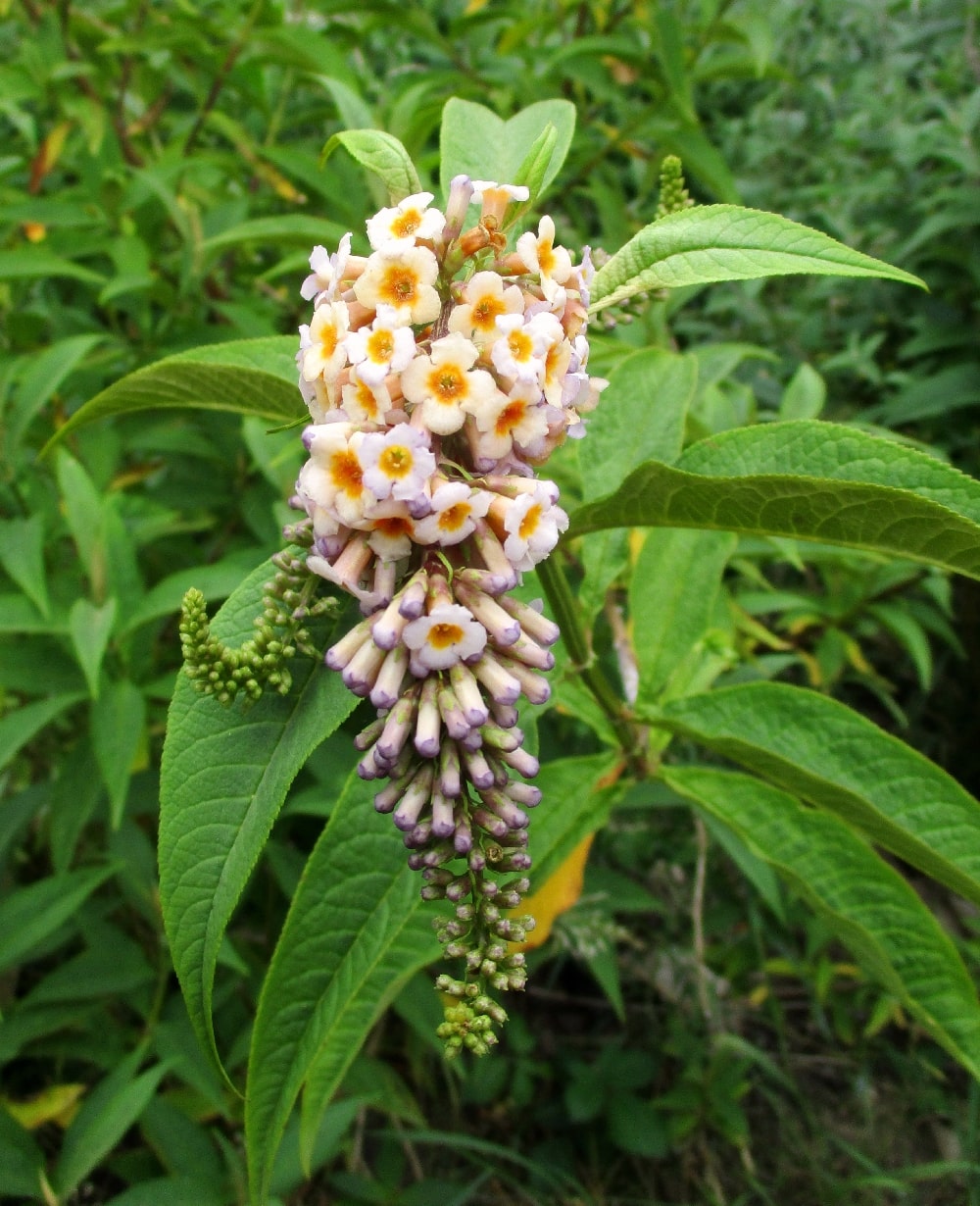
This B. forrestii develops a yellow cast to the flowers as they mature.
Open full size image in a new window
Buddleja globosa
'Beryl'
14th June 2022
There's not much choice when it comes to B. globosa flowers. Most are orange, the exceptions being HCM98017, which is very pale yellow, and 'Lemon Ball', with underwhelming yellow flowers. The lack of selectively bred cultivars is easily explained - the seedlings are delicate, being prone to both botrytis and root rot, and the plants can be slow to mature.
I've only had very modest success breeding new B. globosa plants, and have produced two yellow-flowered plants by crossing a generic orange female with HCM98017. One is a male called 'Kevin' and the one shown, a female full-sibling called 'Beryl'. The original seedling was raised in 2012, but that died after a couple of years. The plant I have is a cutting of a cutting, and now five or six years old. I'm pleased with 'Beryl', as females can be less showy and less floriferous. There are plenty of flowers and the balls are reasonably big. The scent is stronger too, and very like dandelion. A close-look at the flowers shows a lack of stamens, and these female flowers are described as pistillate, as opposed to the male staminate flowers with a non-functional, but still visible, pistil.
I'm raising seedlings of 'Beryl' backcrossed to HCM98017 (male) in order to produce a true lemon yellow, although I think the chances of realising that goal are rather slim. They have yet to flower and must survive another perilous winter before they can do so.
There is much more about this species, including a photo of 'Kevin', on the dedicated B. globosa and B. araucana page.
Buddleja species
C&H 7039 (F2)
1st June 2022
Royal Botanic Gardens Edinburgh kindly sent me seeds from some of their Buddlejas a few years ago. Always keen to grow new plants, I sowed the seeds and, after a couple of seasons, the results are starting to flower. The one shown was raised from the seed of C&H (Cox and Hutchison) 7039, a plant collected from South Sichuan (China) in 1995 and growing at their Benmore Botanic Garden in Argyllshire. Currently, the plant is catalogued as Buddleja macrostachya by the RBGE.
C&H 7039 is almost certainly self-fertile and, as far as I can tell, is coming more or less true from seed. The leaves of the seedlings are large and felted and the stems are covered in woolly hair; both are more in keeping with B. nivea and unlike B. macrostachya, which is significantly less hairy. However, species identification can be rather hit-and-miss without flowers to examine.
Now I can examine them, I can see the flowers are totally unlike B. macrostachya. They have a short funnel-shaped (infundibular) corolla tube compared to the long cylindrical corolla tube of B. macrostachya. Looking closely at the flowers of the commonly available plant of B. nivea type: yunnanensis for comparison, the similarity is evident, differing only in the length of the calyx. I'm convinced C&H 7039 is in fact Buddleja nivea, and most closely corresponding to the type: yunnanensis, which typically flowers about now - six weeks ahead of any B. macrostachya
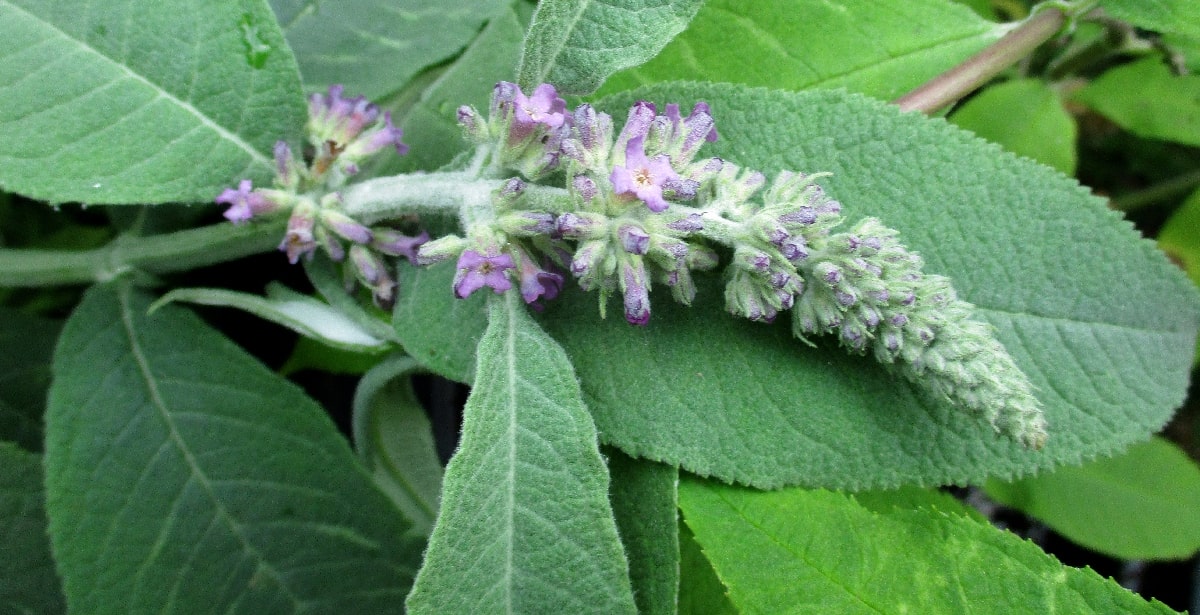
This plant is most likely B. nivea type: yunnanensis.
Open full size image in a new window
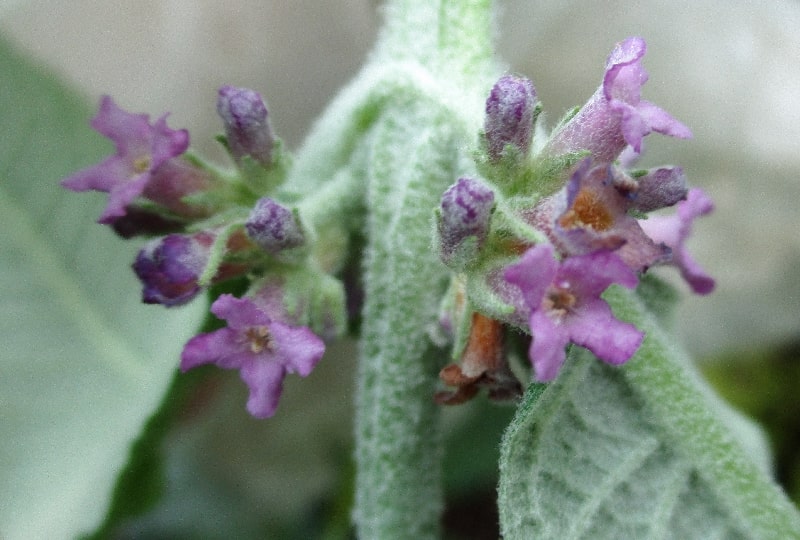
Close up, the flowers are similar to B. nivea type: yunnanensis.
Open full size image in a new window
Buddleja colvilei - an old collection
23rd May 2022
When I saw an old Buddleja colvilei in the Birmingham Botanical Garden, I couldn't resist asking for cuttings. And the head gardener generouly allowed me to have some material. Now these cuttings are mature plants and they are flowering nicely this spring.
There is no information on the origins of this plant; there have been numerous B. colvilei introductions, starting in the 19th century, so it's anyone's guess where this came from. The form of this collection, which I'm calling 'BBG', is quite distinctive - the leaves are somewhat felted, and their overall appearance is very like the popular 'Kewensis' cultivar. The flowers are very different - they are large, up to 3cm in diameter ('Kewensis' has relatively small flowers for the species) and have a contrasting bright white throat. The main corolla colour is red-pink, not quite as dark as 'Kewensis' and the petals tend to be folded back.
I wonder whether there is some mileage in selectively breeding new ex situ examples of this species, developing improved hardiness and larger, more showy flowers. Such an endeavour would require patience - the seedlings don't flower for several years - and space, as the true form is only apparent in large, mature specimens.
Buddleja colvilei seedling
9th May 2022
A few years back, I was able to cross the pink form of B. colvilei with the 'Kewensis' cultivar. I'm not surprised there's so little selective breeding of these larger Buddleja species as the seedlings take several years to flower, and B. colvilei has proved one of the slowest. Finally, I've managed to make one of my seedlings flower.
The seedling's flowers are almost perfectly intermediate between the parents, which can be compared here. 'Kewensis' has a smaller individual flowers, but those of the seedling are larger and have a white throat like the pale pink parent. The corolla though is a deeper and more intense pink, although not as dark as 'Kewensis', which can be almost maroon in colour.
I grew the seedlings for the sake of curiosity. Although not massively different from the B. colvilei collections and cultivars already available, this one is nice enough to keep. Another year in a pot and it should be large enough to plant outside. I'll have to also repot and heavily feed its siblings to encourage their flowering next spring, and maybe I'll get something truly unique.
Buddleja tsetangensis
Hybrid, subspecies or species?
23rd April 2022
I've had Buddleja collection KR4881 growing in my garden for a few years now, and it's proved shy to flower - and when it does, the effect is underwhelming. For a plant from Tibet, it's remarkably intolerant of frost, losing most of its flower-buds each year unless the spring is particularly mild. Despite this, the plant healthy and has grown into a small straggly tree with a rather congested habit (the grey, toothed leaves are densely packed with exceptionally short-internodes).
The inflorescences are formed on the lateral branches formed the previous year; these are clusters of flowers in the form of glomerules or congested cymes. Other than being off-white and appearing a little earlier in the season, they are essentially the same as the more common form of B. alternifolia. It does differ in keeping much of its foliage over a typical English winter, whereas B. alternifolia is fully deciduous.
Although KR4881 was originally identified as B. x wardii, I don't believe there is any evidence for it being from the hybridisation of B. crispa and B. alternifolia. It corresponds exactly to Buddleja tsetangensis, sunk as a synonym of B. alternifolia by Leeuwenberg (1979). A specimen of Buddleja tsetangensis was collected in the Tsang-Po valley of Tibet and sent to Edinburgh in 1924 by the plant hunter F. Kingdon Ward. Described by Kingdon Ward as a small gnarled tree, locally common, and flowering in April, the flowers cream with an orange throat.
KR4881 does merit recognition as something distinct, and personally I might be tempted to consider it as a variety or subspecies - B. alternifolia var. tsetangensis - rather than a species in its own right or as merely a local Tibetan form of B. alternifolia.
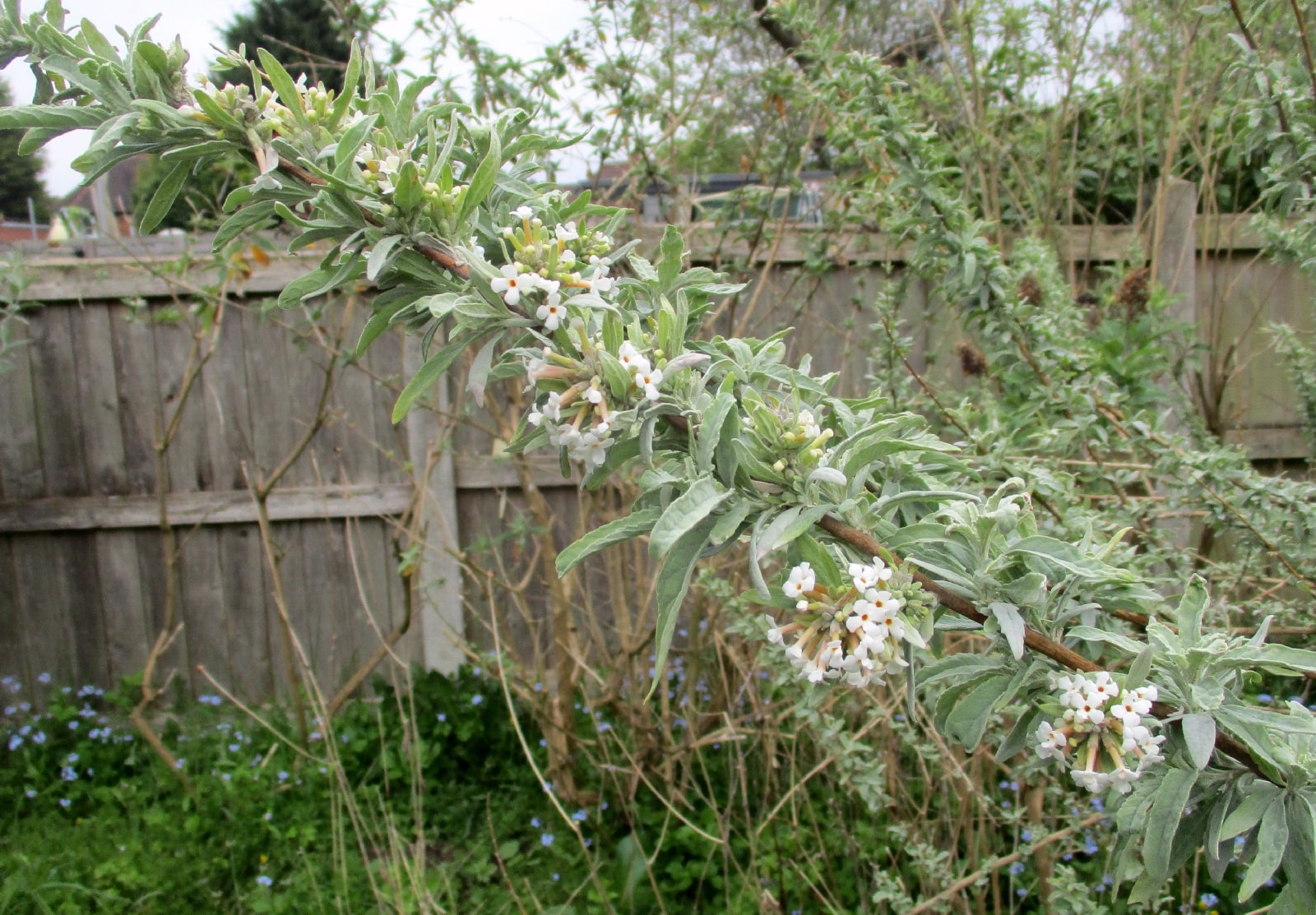
B. tsetangensis has inflorescences along its lateral branches
Open full size image in a new window
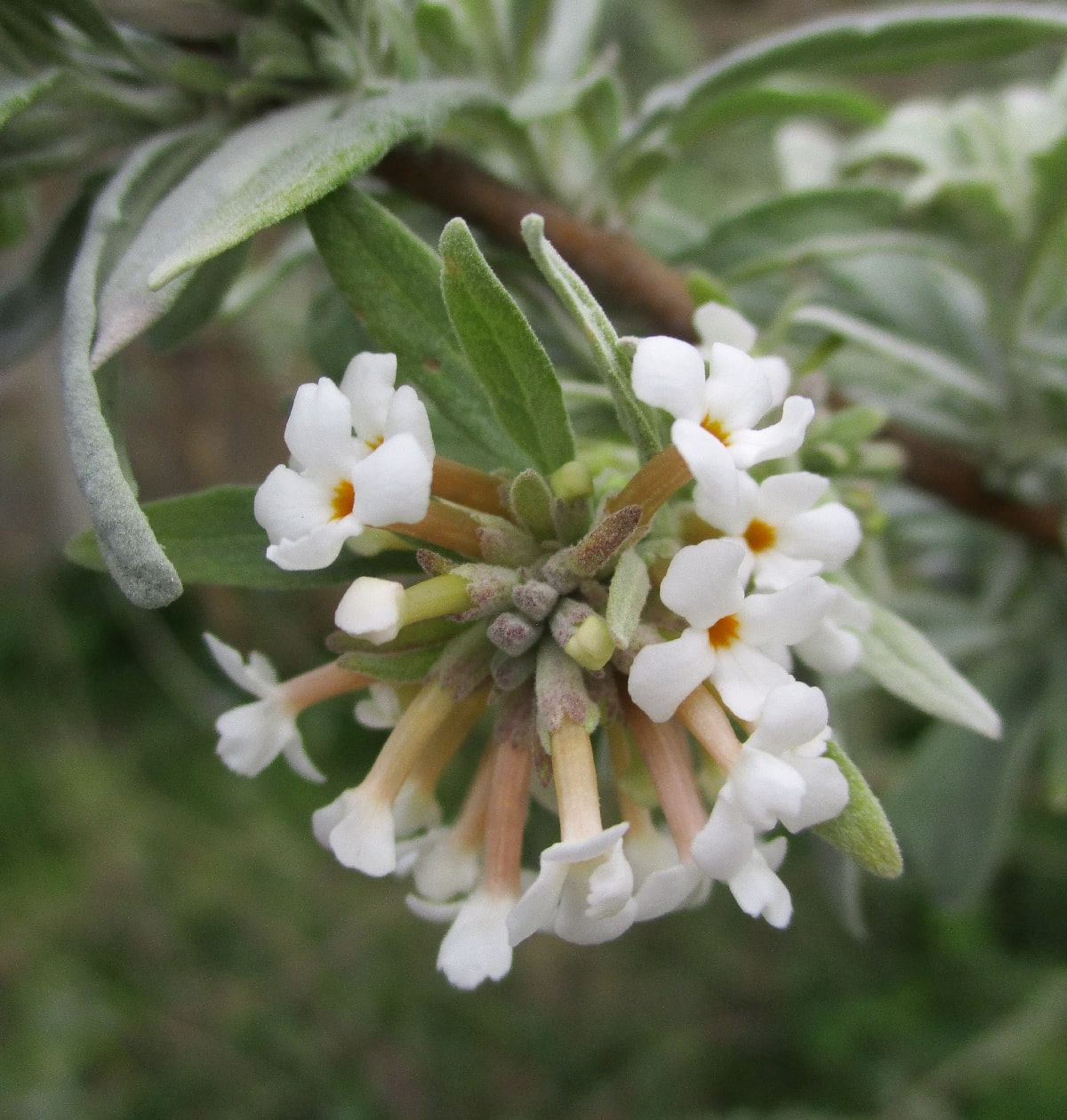
Close-up of a flower cluster
Open full size image in a new window
Buddleja salviifolia
A New Colour
19th April 2022
A while back I bought some seeds of Buddleja salviifolia from a reputable source in South Africa. They've taken a while to mature, and I now have four mature and healthy plants. The two kept outside haven't flowered and I suspect these seedlings are a little less hardy than the common blue cultivar sold in most nurseries. Maybe they will become more robust as they get older - I've certainly found the white form, which my seedlings resemble more than the blue form, to become significantly hardier with age.
Last year, a seedling with lilac flowers bloomed in my greenhouse, which has flowered again this year with a consistent colour. A different seedling has just opened a delicate violet in colour, fading to almost cream as the flowers age. B. salviifolia is very variable species, and various shades of lilac and violet are common in Africa, although these colours are rare in cultivation.
Many species are represented in collections and in the horticultural trade by just one or two atypical clones. Conversely, I've become more interested observing several different examples of a single species and maintaining a wider ex situ genepool. I don't think these Buddleja salviifolia with their averagely coloured flowers will have a greater appeal than the already available plants, but they are something I couldn't have obtained any other way than by growing from seed.
The New Buddleja Year
1st January 2022
Another year begins in The Buddleja Garden. There's never much happening in the bleak midwinter, so I thought I would mention a project with which I've been involved. Trees and Shrubs Online (TSO), managed by the International Dendrology Society and sponsored by the John Spedan Lewis Foundation, is an online resource cataloguing and describing the woody plants grown in temperate gardens, parks, arboretums and so forth. It's a monumental undertaking, and has much to live up to as the online successor to the revered Bean's Tree and Shrubs.
I was rather honoured to be asked to contribute the Buddleja pages. The job is almost complete and the Buddleja pages can now be found via the Buddleja Genus page. There's still a little way to go, for example I've yet to properly systematise and describe the new dwarf hybrids.
Please do have a look, both at the Buddleja pages and the rest of the site. When complete, I don't think there will a single reference work on the internet, or in print for that matter, that will come close to Trees and Shrubs Online, which aims to be up-to-date, meticulous and comprehensive.

The antique illustration, just for decoration, is one of my favourites: Buddleja x intermedia, a hybrid of B. lindleyana and B. japonica, raised in France many years ago.
Email:
buddlejagarden@gmail.com
© The Buddleja Garden 2011-2024.
